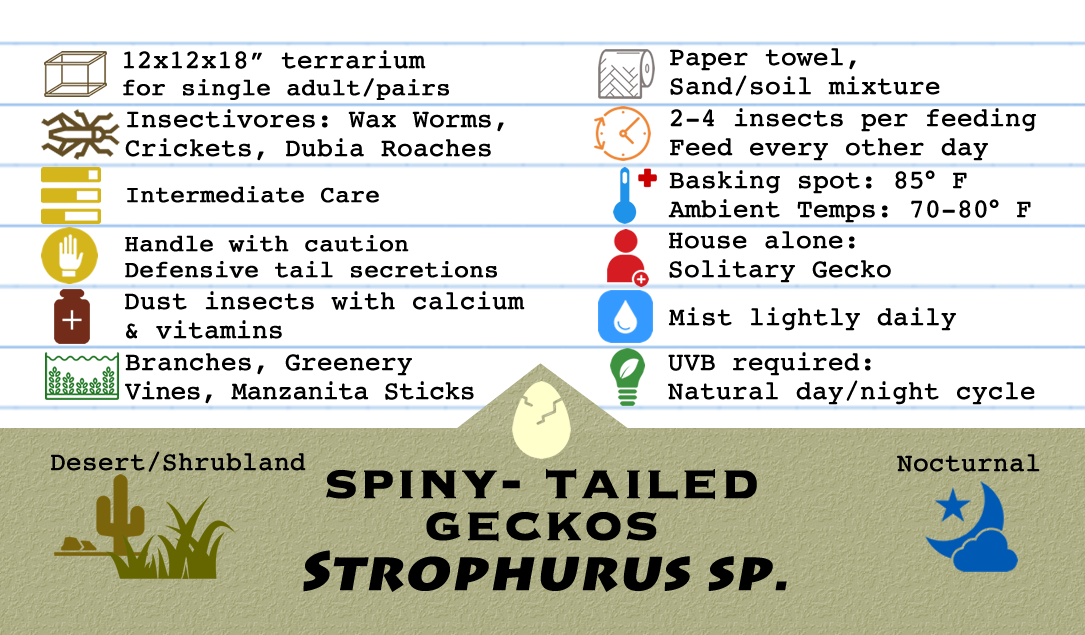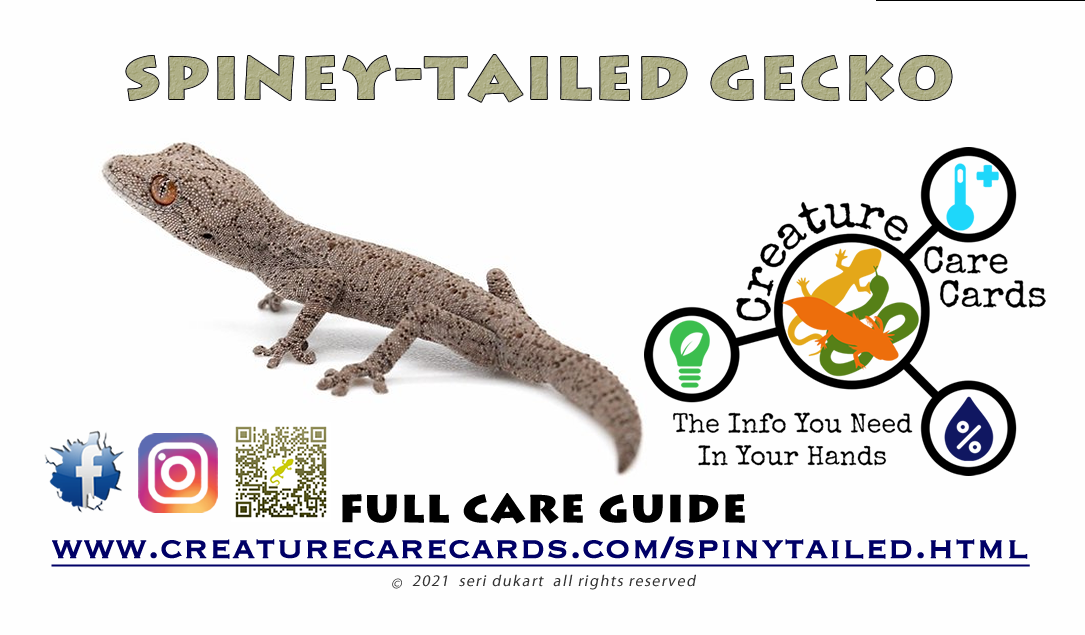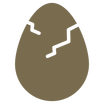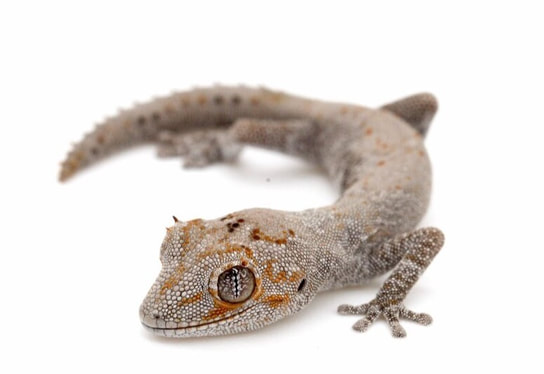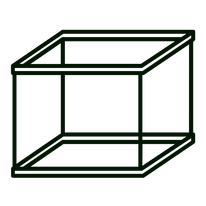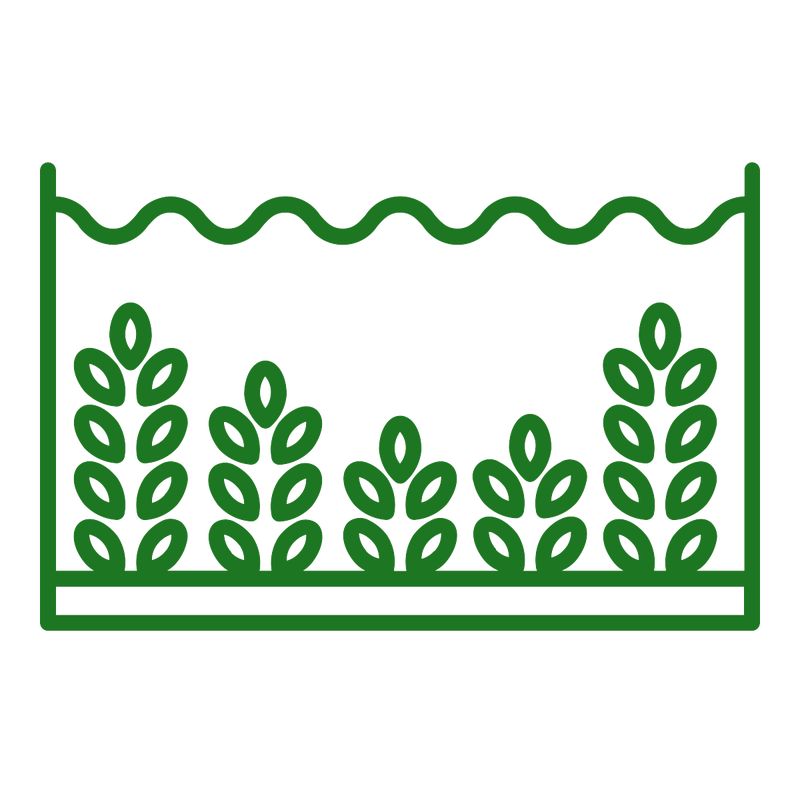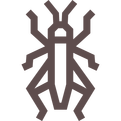Strophurus sp. - Spiny-tailed Geckos
Strophurus geckos are a genus of Diplodactylidae. There are about 20 recognized species of Strophurus gecko, and some are commonly called Spiny-tailed geckos, Golden Tailed Geckos, Striped Geckos or Phasmid Geckos. They are endemic to Australia and are a desert/shrublands gecko, often found in tall grasses or shrubs. They have the unique ability to squirt a harmless but foul smelling fluid from their tails.
Strophurus species include S.assimilis, S. ciliaris, S. congoo, S. elderi, S. horneri, S. instermedius, S. jeanae,
S. krisalys, S. mcmillani, S. michaelseni, S.rankini, S.robinsoni, S.spinigerus, S.strophurus, S.teaniatus, S.trux,
S. wellingtonae, S. williamsi and S.wilsoni.
S. krisalys, S. mcmillani, S. michaelseni, S.rankini, S.robinsoni, S.spinigerus, S.strophurus, S.teaniatus, S.trux,
S. wellingtonae, S. williamsi and S.wilsoni.
|
Bringing Your New Pet Home
When you bring your new gecko home, you should already have a quarantine tank set up and ready to go. Place fresh water in a bowl in the tank, mist the tank and offer food, but be aware it is completely normal for them to refuse food for the first couple days, or even longer. You should keep this new gecko separate from any other geckos you may have for 90 days, to ensure there is nothing it could spread to your other animals. Monitor its eating and fecals as they may be strange for up to a couple weeks, but this is due to a new diet, supplements, and environment. It is recommended you do not handle your new gecko for the first 24-48 hours and keeping it to a minimum until it has started eating on its own. Always keep in mind, your new animal is in a new tank, with new decor/dishes/hides, and new faces watching them. They need time to become acclimated to it all. After this quarantine process, they can be safely introduced to their permanent enclosure if it's not already. Be sure to wash your hands before handling any other geckos during this time. |
|
Enclosure Depending on your need, there are a couple different ways to house a strophurus gecko. For a single gecko, a glass or PVC front opening terrarium with a screen top or door would be the most appealing. The general rule of thumb, is to have 10 gallons of tank for a single gecko or a pair. Babies and juveniles require less space, but you will need to upgrade as they grow. Some keepers modify plastic tubs with screen to keep their geckos as well. a 12 x 12 x 18" arboreal terrarium is suitable for a single adult or pair for most species. Larger species require more space. Be sure to research your specific species for more in depth information on required space. Babies can be housed in smaller enclosures until they reach adulthood. a 8x8x12" terrarium is ideal for a baby as they can find their food easier. We highly recommend Zen Habitats enclosures for adults! 
Research bio-active and naturalistic, planted terrariums for more advanced options!
|
|
Substrate
Strophurus geckos thrive best on simple substrates such as paper towel or a sandy soil mixture. Loose substrates should be used with caution; geckos can ingest it while hunting bugs and become impacted. If you use loose substrates, it is best to feed out of enclosure or by tongs. Change paper towel weekly. Female geckos will lay eggs when they reach breeding age, even if they were never with a male. It is best to provide all female geckos with a lay box with loose substrate for them to lay their eggs and prevent egg binding. |
|
Compatibility
Geckos by nature are solitary animals. In strophurus geckos, females can be housed together with caution. They must be of the same size to prevent bullying. If you do choose to house more than one gecko together, more space is needed, with an additional 5 gallons of space per additional gecko. Adding more hides and decor will help prevent fighting. Males will fight with one another, and geckos of different sizes will bully and attack one another. Do not house males and females together unless you have researched breeding and are prepared for eggs and babies. Be sure both specimen are of breeding age before housing together. Monitor females to be sure they are not picking on one another or one is not hoarding the food from the other. |
|
Lighting
Strophurus geckos are nocturnal, meaning they are active at night. They should be exposed to 10-12 hours of light per day. UVB lighting is required as this species has shown to benefit from the addition of UVB or UVA light. Lights should be placed on a timer so the gecko has darkness at night, when they are most active.
|
|
Cage Decor
Since they are nocturnal and arboreal, they need to have places to hide from the daylight to sleep and climb. You will most often find strophurus geckos hanging out in branches or grasses, so decorate the tank heavily with fake greenery, branches, with the addition of cork bark and cork rounds. Manzanita wood branches are highly preferred, as well as various vines and bendable branches. |
|
Humidity and Shedding
Being a desert species, humidity is not a big concern for this species. Misting the enclosure lightly once a day will keep the humidity at a desirable level. Doing so in the evening hours is advised as most geckos prefer to hydrate by drinking water droplets off leaves and branches. Stophurus geckos will shed their skin as they grow and regularly as adults. You’ll notice their color will appear dull when they are about to shed. Generally, the gecko will eat all of their shed, but you may see some of the shed skin in the cage. Some geckos will have unshed skin on their toes, we suggest letting your gecko soak in a shallow container of lukewarm water for a few minutes and you can assist the process by gently removing the skin using tweezers. Stuck shed is often an indication of humidity issues, so you can help this by misting more often or heavier.
|
|
Water
Your strophurus gecko should have access to fresh, clean water in a shallow bowl at all times. Some will not drink directly from bowls and prefer to lick water from misting off leaves, but many have been seen drinking from bowls. Water can be treated with a commercial water treatment to remove any harsh chemicals from the water. |
|
Feeding Strophurus geckos are insectivores. Typically, their diet consists of small insects like fruit flies, crickets, wax worms or dubia roaches. Insects should be of appropriate size to prevent regurgitation, being no larger than the space between their eyes. Too much food can also cause regurgitation, so it is best to feed a few food items at a time. Insects should be gutloaded with a commercial gutload product. Gutloading refers to the practice of feeding the insects a nutritious diet before offering them to your gecko, to ensure the most balanced nutrition. Insects can be offered every other day, about 2-4 insects per feeding per gecko. Uneaten insects should be removed after a few hours. |
|
Handling
Strophurus geckos are a sensitive, easily stressed species. It is best to not handle them unless necessary. When threatened or agitated, strophurus are capable of squirting a pungent smelling sticky substance from their tails. The substance can be irritating and is very foul smelling. It is actually highly flammable when mixed with ammonia. Geckos that are used to human interaction are not as likely to do this as long as care is taken not to startle them too much. |
